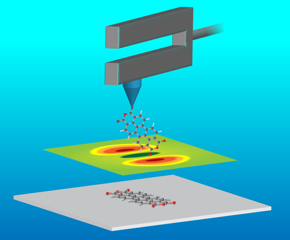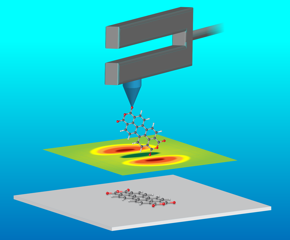Pushing the Potential of Probe Microscopy
Musing over the most important scientific “sound bite” to pass onto future civilizations, Richard Feynman opted for: “All things are made of atoms—little particles that move around in perpetual motion, attracting each other when they are a little distance apart, but repelling upon being squeezed into one another.” [1]. It is perhaps no wonder then that Feynman said that it was akin to a “religious experience” when he saw atoms for the first time with a scanning tunneling microscope (STM) [2]. We can only guess, but he would probably have been just as impressed with STM’s sibling technique, atomic force microscopy, which allows us to probe the atomic forces he found so elemental to our scientific understanding. Now, Christian Wagner from the Jülich Research Center (Forschungszentrum Jülich) in Germany and his co-workers have pushed the capabilities of force microscopy to a new level by attaching a single molecule at the sharp end of an STM probe and exploiting it as a quantum dot capable of sensing electrostatic fields [3]. The molecular quantum dot terminating the tip allows the electrostatic potential to be mapped out around a target atom or molecule, thus giving even deeper insights into the atomic-scale forces which so fascinated Feynman. The increased sensitivity offered by this technique could be used to characterize rough surfaces, adsorbed materials on semiconductors, or artificial nanostructures.
At the core of Wagner et al.’s approach is a well-established technique called dynamic force microscopy (also known as noncontact atomic force microscopy, NC-AFM [4]). In common with all scanning probe techniques, NC-AFM involves bringing an exceptionally sharp tip—terminated in a single atom or molecule—within a few atomic diameters of a sample surface. Often, the target of interest is a single atom or molecule adsorbed on the surface. Forces between the atomically sharp probe and the underlying sample are measured by exploiting the properties of that staple of undergraduate physics courses: the harmonic oscillator. The probe is attached to the end of a cantilever, or, as is increasingly the norm in the field, a tine of a micromachined quartz tuning fork [5], which is oscillated at its resonant frequency and swept back and forth across a surface using piezoelectric actuators. The tip of the probe experiences different forces (related to, for example, chemical bond formation or, at smaller tip-sample separations, the Pauli exclusion principle), which produce a shift in the resonant frequency of the tine. By measuring these shifts at different distances, the potential energy of the tip-sample interaction can be extracted.
In this way, NC-AFM has underpinned a series of remarkable discoveries and developments in single-atom/single-molecule imaging and spectroscopy over the last decade. In particular, researchers have produced exceptionally clear images of the internal structure and bonding framework of single molecules [6], pioneering a new subfield of ultrahigh resolution NC-AFM imaging [7]. These molecular maps can provide better understanding of, for example, the atomic rearrangements that occur during chemical reactions.
Despite these and other advances [8], it has proven rather difficult to reliably map and interpret the electrostatic potential of single atoms and molecules. The technique used to do this, Kelvin probe force microscopy (KPFM), is a variant of NC-AFM where the shift in the resonant frequency of the cantilever is measured as a function of the applied voltage , between the tip and sample. Researchers measure the voltage that minimizes and from that they estimate the electrostatic interactions above the sample surface [9]. Unfortunately, KPFM can often be fraught with both experimental and theoretical challenges when it comes to interpreting the curve and how it depends on the tip-sample separation.
In order to circumvent some of the limitations of KPFM and to improve the sensitivity of NC-AFM to electrostatic potentials associated with single atoms and molecules, Wagner et al. have cleverly borrowed from a strategy used extensively to study quantum dots. Quantum dots have distinct energy levels that shift when exposed to an electrostatic field. Physicists utilize this so-called electrostatic gating to ascertain electronic structure and transport properties. Wagner et al. have “inverted” the technique by using a quantum dot as a sensor for an electrostatic potential. They terminate the tip of their force microscope with a molecule (see Fig.1), which behaves like a quantum dot in the sense that it has sharp energy levels resulting from a weak interaction with the rest of the tip. The key idea to this approach is that the energy levels of the molecular quantum dot are gated (i.e., shifted) by the electrostatic potential of the target molecule or atom located on the sample surface.
The scanning quantum dot microscope creates images by recording the effects of sample-induced electrostatic gating. The shifts in the dot’s energy levels directly affects the probability for an electron to tunnel from the tip onto the tip-adsorbed quantum dot, or vice versa. These charging/discharging events are the key experimental “observable”—they appear as sharp spikes in a curve. By taking many spectra across a single molecule or atom, Wagner et al. can identify the (dis)charging events and, from these, construct the electrostatic potential underpinning the electron transport. This allows the team to produce three-dimensional maps of the electrostatic potential associated with single atoms and molecules with exceptionally high sensitivity.
The exploitation of electrostatic gating is certainly not new in scanning probe microscopy, indeed, there’s a relatively well-known technique called scanning gate microscopy [10]. However, the particular realization of the approach introduced by Wagner et al., and its seamless integration within ultrahigh resolution NC-AFM, is novel and has particularly exciting potential. I am keen to see the technique applied to atoms and molecules on semiconductor surfaces where, under appropriate circumstances, the electronic structure of the substrate under the tip can be dramatically affected by the presence of an adsorbate or, indeed, a scanning probe.
There are also fascinating possibilities for combining quantum dot microscopy with single-atom or single-molecule positioning, in which a scanning probe is used to construct nanostructures element-by-element. This atomic manipulation—augmented by highly sensitive force mapping—would allow researchers to create, and tune, tailor-made electrostatic potentials that underlie physical phenomena like quantum confinement and electron scattering. After all, and if I can be forgiven just one more Feynman quote to close, “What I cannot create, I do not understand.”
This research is published in Physical Review Letters.
References
- Richard P Feynman, Robert B Leighton, and Matthew Sands, The Feynman Lectures on Physics (Addison-Wesley Publishing Company, Massachusetts, 1963), Vol 1, p.1-2
- Quoted in Wayne M. Saslow, Electricity, Magnetism, and Light, (Academic Press, Amsterdam, 2002)[Amazon][WorldCat]
- Christian Wagner, Matthew F. B. Green, Philipp Leinen, Thorsten Deilmann, Peter Krüger, Michael Rohlfing, Ruslan Temirov, and F. Stefan Tautz, “Scanning Quantum Dot Microscopy,” Phys. Rev. Lett. 115, 026101 (2015)
- F. J. Giessibl, “Advances in Atomic Force Microscopy,” Rev. Mod. Phys. 75, 949 (2003)
- F. J. Giessibl, “High-Speed Force Sensor for Force Microscopy and Profilometry Utilizing a Quartz Tuning Fork,” Appl. Phys. Lett. 73, 3956 (1998)
- L. Gross, F. Mohn, N. Moll, P. Liljeroth, and G. Meyer, “The Chemical Structure of a Molecule Resolved by Atomic Force Microscopy,” Science 325, 1110 (2009)
- L. Gross, F. Mohn, N. Moll, B. Schuler, A. Criado, E. Guitián, D. Peña, A. Gourdon, and G. Meyer, “Bond-Order Discrimination by Atomic Force Microscopy,” Science 337, 1326 (2012); D. G. de Oteyza et al., “Direct Imaging of Covalent Bond Structure in Single-Molecule Chemical Reactions,” 340, 1434 (2013)
- L. Gross, F. Mohn, P. Liljeroth, J. Repp, F. J. Giessibl, and G. Meyer “Measuring the Charge State of an Adatom with Noncontact Atomic Force Microscopy,” Science 324, 1428 (2009); F. Mohn, L. Gross, N. Moll, and G. Meyer “Imaging the Charge Distribution within a Single Molecule,” Nature Nanotech. 7, 227 (2012)
- S. A. Burke et al., “Determination of Local Contact Potential Differences of PTCDA on NaCl: A Comparison of Techniques,” Nanotechnol. 20, 264012 (2009); J. L. Neff and P. Rahe, “Insights into Kelvin Probe Force Microscopy Data of Insulator-Supported Molecules,” Phys. Rev. B 91, 085424 (2015)
- See, e.g., A. Pioda, S. Kičin, T. Ihn, M. Sigrist, A. Fuhrer, K. Ensslin, A. Weichselbaum, S. E. Ulloa, M. Reinwald, and W. Wegscheider, “Spatially Resolved Manipulation of Single Electrons in Quantum Dots Using a Scanned Probe,” Phys. Rev. Lett. 93, 216801 (2004)





